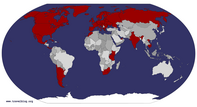Letters from Nigeria
July 25th 1972 -» September 1st 1974
Memories of Spain and Morocco
October 4th 1989 -» October 16th 1989
Our Panama Canal Cruise
March 12th 1992 -» March 28th 1992
Walking in England
July 31st 1998 -» August 30th 1999
With Friends in UAE
April 13th 2000 -» April 25th 2000
Inside Passage to Alaska
August 7th 2004 -» August 15th 2004
Pacing Bermuda
February 5th 2005 -» February 11th 2005
Mellowing in Italy
April 28th 2007 -» May 28th 2007
Jane Austen's England
September 19th 2008 -» October 9th 2008
Panama Land and Water
February 8th 2010 -» February 16th 2010
European River Cruise
August 16th 2010 -» August 31st 2010
Return to England
September 6th 2010 -» September 14th 2010
Ancient Athens and Cyclades
April 19th 2011 -» May 4th 2011
Ontario Visit
June 21st 2011 -» June 23rd 2011
In India
January 14th 2012 -» February 4th 2012
Walking in the Rockies 2012
June 29th 2012 -» September 28th 2012
The Wines of Argentina and Chile
March 9th 2013 -» March 25th 2013
Walking in the Rockies 2013 - 2014
April 25th 2013 -» July 11th 2014
Newfoundland & Labrador
August 8th 2014 -» August 20th 2014
Astounding Southern Africa
February 13th 2015 -» March 12th 2015
Encountering Cambodia and Vietnam
February 16th 2016 -» March 11th 2016
Walking in the Rockies 2016
April 28th 2016 -» October 31st 2016
Playful Costa Rica
November 8th 2016 -» November 21st 2016
Big Cities
May 14th 2017 -» June 27th 2017
Walking in the Rockies 2017
July 7th 2017 -» September 29th 2017
Song in My Heart: Ireland, N Ireland, Scotland, England
July 25th 2018 -» August 22nd 2018
Around the Adriatic
April 1st 2019 -» April 22nd 2019
Cultural Cuba
January 7th 2020 -» January 18th 2020
Calgary Parklands 2020
June 12th 2020 -» December 30th 2020
Calgary Parklands 2021
March 12th 2021 -» June 30th 2021
Calgary Parklands 2022
January 14th 2022 -» October 21st 2022
Safari: Kenya and Tanzania
October 27th 2022 -» November 17th 2022
Summer Holidays 2023
May 31st 2023 -» October 3rd 2023






































